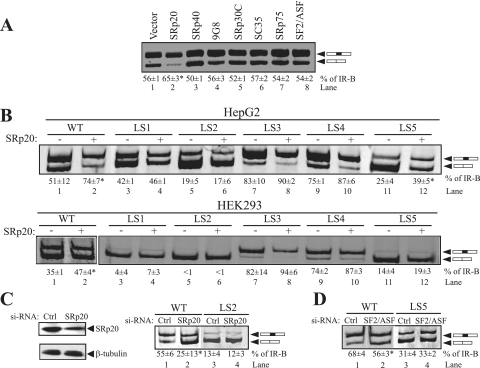FIG. 3.
SRp20 increases IR exon 11 inclusion in vivo by binding to the ESE. (A) The IR minigene (500 ng) was cotransfected with 1 μg of seven individual SR protein expression vectors in HepG2 cells, and spliced products were analyzed by RT-PCR. A representative gel is shown. The mean percentages of exon 11 inclusion (% IR-B) ± SD derived from three independent experiments are given below the gel. (B) Linker-scanning mutants LS1 to LS5 were cotransfected with 1 μg of SRp20 protein expression vector in HepG2 (upper) and HEK293 (lower) cells, and spliced products were analyzed by RT-PCR. Representative gels are shown. The mean percentages of exon 11 inclusion (% IR-B) ± SD are shown below the gel (n = 3). WT, wild type. (C) The wild-type minigene or the LS2 mutant (500 ng) was cotransfected into HepG2 cells with 100 nM siRNAs directed against SRp20 or scrambled control siRNA. SRp20 protein content was measured by immunoblotting with anti-SRp20 monoclonal antibodies (left). The blot was stripped and reprobed for beta-tubulin protein expression as an internal control. Representative results are shown for RT-PCR analysis of the spliced products amplified from RNA isolated from HepG2 cells treated with si-SRp20 (right). (D) Representative RT-PCR analysis of the spliced products amplified from RNA isolated from HepG2 cells treated with SF2/ASF siRNA. Asterisks indicate statistical significance (P < 0.05) relative to levels for the vector control (A and B) or the control scrambled siRNA (C and D).

